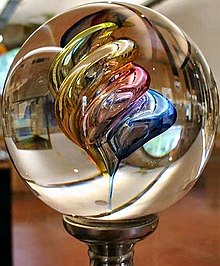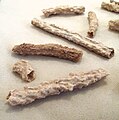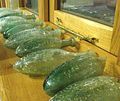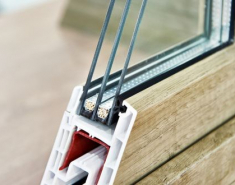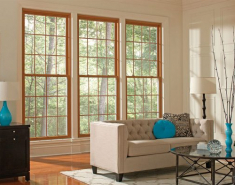More Information on Glass
Glass
Glass is an amorphous solid (non-crystalline) material that exhibits a glass transition, which is the reversible transition in amorphous materials (or in amorphous regions within semicrystalline materials) from a hard and relatively brittle state into a molten or plastic state. Glasses are typically brittle and can be optically transparent. The most familiar type of glass is soda-lime glass, which is composed of about 75% silicon dioxide (SiO2), sodium oxide(Na2O) from sodium carbonate (Na2CO3), lime (CaO), and several minor additives. The term glass is often used to refer only to this type of material.
Silicate glass generally has the property of being transparent. Because of this, it has many applications. One of its primary uses is as a light-transmitting building material, traditionally as small panes set into window openings in walls, but in the 20th-century often as the major cladding material of many large buildings. Glass is both reflective and refractive of light, and these qualities can be enhanced by cutting and polishing to make optical lenses, prisms, fine glassware, and optical fibers for high speed data transmission by light. Glass can be colored by adding metallic salts, and can also be painted. These qualities have led to the extensive use of glass in the manufacturing of art objects and in particular, stained glass windows.
Although brittle, glass is extremely durable, and many examples of glass fragments exist from early glass-making cultures. Because glass can be formed or molded into any shape, and also because it is a sterile product, it has been traditionally used for vessels: bowls, vases, bottles, jars and drinking glasses. In its most solid forms it has also been used for paperweights, marbles, and beads. When extruded as glass fiber and matted as glass wool in a way to trap air, it becomes a thermal insulating material, and when these glass fibers are embedded into an organic polymer plastic, they are a key structural reinforcement part of the composite material fiberglass.
In science, the term glass is defined in a broader sense, encompassing every solid that possesses a non-crystalline (i.e. amorphous) structure and exhibits a glass transition when heated towards the liquid state. These sorts of glasses can be made of quite different kinds of materials: metallic alloys, ionic melts, aqueous solutions, molecular liquids, and polymers. For many applications (bottles, eyewear) polymer glasses (acrylic glass, polycarbonate, polyethylene terephthalate) are a lighter alternative to traditional silica glasses.
Silicate glass
Ingredients
Silica (the chemical compound SiO2) is a common fundamental constituent of glass. In nature, vitrification of quartz occurs when lightning strikes sand, forming hollow, branching rootlike structures called fulgurite.
Fused quartz is relatively chemically-pure silica, or SiO2, which is not in crystalline form but rather in vitrified or glass form, with no true melting point. It can be used for some special glass applications. However, this is not very common due to silica’s high glass transition temperature of over 1200 °C (2192 °F).[1] Normally, other substances are added to simplify processing. One is sodium carbonate (Na2CO3, “soda”), which lowers the glass transition temperature. However, the soda makes the glass water soluble, which is usually undesirable, so lime (calcium oxide[CaO], generally obtained from limestone), some magnesium oxide (MgO) and aluminium oxide (Al2O3) are added to provide for a better chemical durability. The resulting glass contains about 70 to 74% silica by weight and is called a soda-lime glass.[2] Soda-lime glasses account for about 90% of manufactured glass.
Most common glass contains other ingredients to change its properties. Lead glass or flint glass is more ‘brilliant’ because the increased refractive index causes noticeably more specular reflection and increased optical dispersion. Adding barium also increases the refractive index. Thorium oxide gives glass a high refractive index and low dispersion and was formerly used in producing high-quality lenses, but due to its radioactivity has been replaced by lanthanum oxide in modern eyeglasses.[citation needed] Iron can be incorporated into glass to absorb infraredenergy, for example in heat absorbing filters for movie projectors, while cerium(IV) oxide can be used for glass that absorbs UV wavelengths.[3]
The following is a list of the more common types of silicate glasses, and their ingredients, properties, and applications:
- Fused quartz, also called fused silica glass, vitreous silica glass, is silica (SiO2) in vitreous or glass form (i.e., its molecules are disordered and random, without crystalline structure). It has very low thermal expansion, is very hard, and resists high temperatures (1000–1500 °C). It is also the most resistant against weathering (caused in other glasses by alkali ions leaching out of the glass, while staining it). Fused quartz is used for high temperature applications such as furnace tubes, lighting tubes, melting crucibles, etc.
- Soda-lime-silica glass, window glass: silica 72% + sodium oxide (Na2O) 14.2% + lime (CaO) 10.0% + magnesia (MgO) 2.5% + alumina (Al2O3) 0.6%. Is transparent, easily formed and most suitable for window glass (see flat glass). It has a high thermal expansion and poor resistance to heat (500–600 °C). It is used for windows, some low temperature incandescent light bulbs, and tableware. Container glass is a soda-lime glass that is a slight variation on flat glass, which uses more alumina and calcium, and less sodium and magnesium which are more water-soluble. This makes it less susceptible to water erosion.
- Sodium borosilicate glass, Pyrex: silica 81% + boric oxide (B2O3) 12% + soda (Na2O) 4.5% + alumina (Al2O3) 2.0%. Stands heat expansion much better than window glass. Used for chemical glassware, cooking glass, car head lamps, etc. Borosilicate glasses (e.g. Pyrex) have as main constituents silica and boron oxide. They have fairly low coefficients of thermal expansion (7740 Pyrex CTE is 3.25×10–6/°C as compared to about 9×10−6/°C for a typical soda-lime glass[5]), making them more dimensionally stable. The lower CTE also makes them less subject to stress caused by thermal expansion, thus less vulnerable to cracking from thermal shock. They are commonly used for reagent bottles, optical components and household cookware.
- Lead-oxide glass, crystal glass: silica 59% + lead oxide (PbO) 25% + potassium oxide (K2O) 12% + soda (Na2O) 2.0% + zinc oxide (ZnO) 1.5% + alumina 0.4%. Because of its high density (resulting in a high electron density) it has a high refractive index, making the look of glassware more brilliant (called “crystal”, though of course it is a glass and not a crystal). It also has a high elasticity, making glassware ‘ring’. It is also more workable in the factory, but cannot stand heating very well.
- Aluminosilicate glass: silica 57% + alumina 16% + lime 10% + magnesia 7.0% + barium oxide (BaO) 6.0% + boric oxide (B2O3) 4.0%. Extensively used for fiberglass, used for making glass-reinforced plastics (boats, fishing rods, etc.) and for halogen bulb glass.
- Oxide glass: alumina 90% + germanium oxide (GeO2) 10%. Extremely clear glass, used for fiber-optic waveguides in communication networks. Light loses only 5% of its intensity through 1 km of glass fiber. However, most optical fiber is based on silica, as are all the glasses above.
Another common glass ingredient is crushed alkali glass or “cullet” ready for recycled glass. The recycled glass saves on raw materials and energy. Impurities in the cullet can lead to product and equipment failure. Fining agents such as sodium sulfate, sodium chloride, or antimony oxide may be added to reduce the number of air bubbles in the glass mixture. Glass batch calculation is the method by which the correct raw material mixture is determined to achieve the desired glass composition.
-
Quartz sand (silica) is the main raw material in commercial glass production
Physical properties
Optical properties
Glass is in widespread use largely due to the production of glass compositions that are transparent to visible light. In contrast, polycrystalline materials do not generally transmit visible light.[7]The individual crystallites may be transparent, but their facets (grain boundaries) reflect or scatter light resulting in diffuse reflection. Glass does not contain the internal subdivisions associated with grain boundaries in polycrystals and hence does not scatter light in the same manner as a polycrystalline material. The surface of a glass is often smooth since during glass formation the molecules of the supercooled liquid are not forced to dispose in rigid crystal geometries and can follow surface tension, which imposes a microscopically smooth surface. These properties, which give glass its clearness, can be retained even if glass is partially light-absorbing—i.e., colored.[8]
Glass has the ability to refract, reflect, and transmit light following geometrical optics, without scattering it. It is used in the manufacture of lenses and windows. Common glass has a refraction index around 1.5. This may be modified by adding low-density materials such as boron, which lowers the index of refraction (see crown glass), or increased (to as much as 1.8) with high-density materials such as (classically) lead oxide (see flint glass and lead glass), or in modern uses, less toxic oxides of zirconium, titanium, or barium. These high-index glasses (inaccurately known as “crystal” when used in glass vessels) cause more chromatic dispersion of light, and are prized for their diamond-like optical properties.
According to Fresnel equations, the reflectivity of a sheet of glass is about 4% per surface (at normal incidence in air), and the transmissivity of one element (two surfaces) is about 90%. Glass with high germanium oxide content also finds application in optoelectronics—e.g., for light-transmitting optical fibers.
-
A wine glass
-
Simple optical device: the magnifying glass
-
Glass petri dish
Other properties
In the process of manufacture, silicate glass can be poured, formed, extruded and molded into forms ranging from flat sheets to highly intricate shapes. The finished product is brittle and will fracture, unless laminated or specially treated, but is extremely durable under most conditions. It erodes very slowly and can withstand the action of water. It is resilient to chemical attack and is an ideal material for the manufacture of containers for foodstuffs and most chemicals.
Contemporary production
Following the glass batch preparation and mixing, the raw materials are transported to the furnace. Soda-lime glass for mass production is melted in gas fired units. Smaller scale furnaces for specialty glasses include electric melters, pot furnaces, and day tanks.[2] After melting, homogenization and refining (removal of bubbles), the glass is formed. Flat glass for windows and similar applications is formed by the float glass process, developed between 1953 and 1957 by Sir Alastair Pilkington and Kenneth Bickerstaff of the UK’s Pilkington Brothers, who created a continuous ribbon of glass using a molten tin bath on which the molten glass flows unhindered under the influence of gravity. The top surface of the glass is subjected to nitrogen under pressure to obtain a polished finish.[9] Container glass for common bottles and jars is formed by blowing and pressing methods. This glass is often slightly modified chemically (with more alumina and calcium oxide) for greater water resistance. Further glass forming techniques are summarized in the table Glass forming techniques.
Once the desired form is obtained, glass is usually annealed for the removal of stresses. Surface treatments, coatings or lamination may follow to improve the chemical durability (glass container coatings, glass container internal treatment), strength (toughened glass, bulletproof glass, windshields), or optical properties (insulated glazing, anti-reflective coating).
Color
Color in glass may be obtained by addition of electrically charged ions (or color centers) that are homogeneously distributed, and by precipitation of finely dispersed particles (such as inphotochromic glasses).[10] Ordinary soda-lime glass appears colorless to the naked eye when it is thin, although iron(II) oxide (FeO) impurities of up to 0.1 wt%[11] produce a green tint, which can be viewed in thick pieces or with the aid of scientific instruments. Further FeO and Cr2O3 additions may be used for the production of green bottles. Sulfur, together with carbon and iron salts, is used to form iron polysulfides and produce amber glass ranging from yellowish to almost black.[12] A glass melt can also acquire an amber color from a reducing combustion atmosphere. Manganese dioxide can be added in small amounts to remove the green tint given by iron(II) oxide. When used in art glass or studio glass is colored using closely guarded recipes that involve specific combinations of metal oxides, melting temperatures and ‘cook’ times. Most colored glass used in the art market is manufactured in volume by vendors who serve this market although there are some glassmakers with the ability to make their own color from raw materials.




